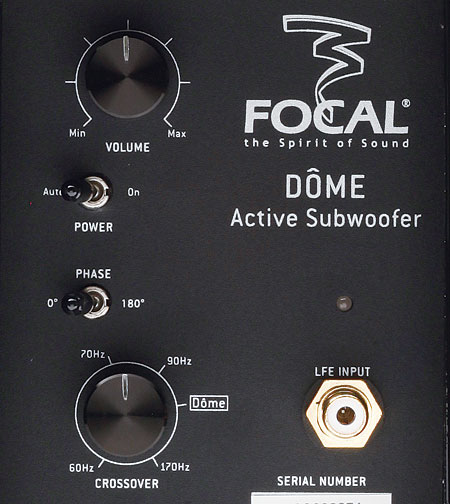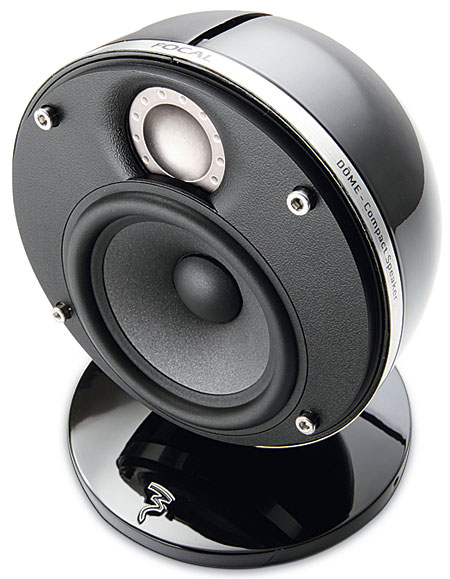Focal Dôme Speaker System Page 2
With its cylindrical shape and rounded top, you wouldn’t mistake the Dôme subwoofer for anyone else’s sub. The 100-watt (RMS) BASH amplifier animates an 8-inch down-firing woofer, with a cone made of Polyflex, a stiffened plastic. The spec sheet lists the enclosure as bass-reflex, which threw me for a couple of days, because I couldn’t find the port. Finally I flipped over the sub and took a careful look at the driver. Next to it was a slot-shaped port I’d previously missed. Focal is full of surprises.

One thing I don’t mention often enough in sat/sub reviews is that there are limits to the bass output and/or extension you can get out of any speaker, in this case a smallish-for-a-subwoofer 8-inch driver. I can easily live within these limits, but if you want slammin’ effects in action movies, you may not be a compact sat/sub kind of person. In a sat/sub set, a more important task for the sub is to gracefully cross over the satellites. In this system, the dovetailing is very good; it sounds almost seamless.
Associated equipment included a Rotel RSX-1550 A/V receiver, Panasonic DMP-BD35 Blu-ray player, Luxman PD-289 turntable, Shure V97xE phono cartridge, and Bellari VP530 tubed phono preamp. All movies were Blu-ray Discs with Dolby TrueHD soundtracks.
Smoldering in the Rain
Once in a while, I can almost immediately sense the outcome of a listening session. Ten seconds into The International, I knew I was in the presence of greatness. The opening frames show Clive Owen smoldering directly into the camera, with accompanying all-channel rain and thunder. These effects were natural enough to be convincing on an instinc-
tive level. I felt the emotional stimulation I always feel in the presence of rushing rain and rumbling thunder. Yet I could
also perceive the constructed artificiality of the mix. It was sort of like watching a painter adding bold strokes to a canvas.
Voices weren’t just clear and intelligible (usually the only two descriptors I apply to dialogue), they were startlingly present. This wasn’t a hyped or etched approach with exaggerated high frequencies—I didn’t feel that the voices were being distorted. They were just being reproduced with an extraordinarily high level of resolution. Even sotto voce, the dialogue was vivid and lifelike. From the orchestral strings to the occasional drum thud to the epic shootout at New York’s Guggenheim Museum, the Dômes excelled at everything. I got sucked into the plot—a stouthearted investigator takes on a corrupt arms-dealing super-bank—and went long stretches without taking notes.
The Soloist is the true story of a Los Angeles Times columnist who befriends a gifted cellist who’s mentally ill and living on the streets. This harrowing and moving story depends heavily on overlapping dialogue between the unhinged musician and the fast-talking journalist, played with bravura by Jamie Foxx and Robert Downey Jr., respectively. Again, the Dômes’ aptitude for depicting the human voice just about stunned me. Beethoven is virtually another character in the drama, and the speakers aced the snatches of music performed by cellist Ben Hong and the Los Angeles Philharmonic. They are often mixed in a subjective manner to demonstrate the musician’s tentative relationship with the world outside his troubled mind.

I Love You, Man has the standard TV-like soundtrack that’s common to film comedies, with limited dynamics that were hardly expanded at all to accommodate the frequent use of popular songs. Even here, the male voices were extremely realistic. While not chesty, the Dômes did convey the chest resonance of a male voice in a rare and gratifying way. This just made the conceptual story line—about a guy who feels the lack of male friends as his wedding day approaches—even more enjoyable and involving.
Francophilia
The temptation to start the music demos with a French composer proved to be irresistible. Debussy is the focus of disc three of Stokowski: The Maverick Conductor, from the EMI Icons series. Leopold Stokowski conducted “Prélude à l’après-midi d’un Faune,” “Nocturnes,” “Clair de lune” from Suite bergamasque, and “Ibéria” with various orches-
tras in golden-age stereo recordings from 1957 to 1958. This was best-case-scenario material, and the Dômes didn’t disappoint. Strings, played with Stokowski’s preferred “free bowing” technique, were lush, vivid, and sinuous. The top end was neither dumbed down nor exaggerated—it was open, airy, and in the best sense, revealing. The sensuous flute in the opening bars of “Faune” was fully audible, which indicated excellent low-level resolution. The Dômes filled the room with just 2.1 channels nearly as well as they did with 5.1 channels via the Dolby Pro Logic II Music mode. As I often say, one of the hallmarks of a great speaker is that it can work well in stereo.
Billie Holiday’s All or Nothing at All was the third of three double-LP compilations released by Verve in the late 1970s. Though recorded monaurally, circa 1955 and 1956, the sessions were beautifully produced by Norman Granz and represented the final years of the singer’s career. Holiday’s frail voice had acquired a slight rasp by then, but her phrasing and ability to convey emotion were never better. On these records, with the mono signal routed to two channels, the Dômes provided an expanded approach to depth. What might otherwise have been a single point-source effect became three distinct layers. Holiday was usually alone up front, emphasizing both her psychological isolation and her place at the head of the band. The piano and rhythm section were always well in back (my tubed preamp understated the drummer’s neat brushwork). Other instruments were in the middle ground. Occasionally a solo instrument—trumpet, sax, or electric guitar—moved to the foreground, and it would take on an exciting in-the-room feel.
The Chrono Show by Richard Thompson is a conceptual live CD with songs in strictly chronological sequence from every stage of the singer/songwriter’s 40-year career. Thompson plays a Lowden acoustic guitar with a combination of electronic pickup and internal microphone, plus a little echo, and tremolo that varies depending on the song. The CD faithfully documents this carefully honed sound. It conveys both the power of the rhythm parts played with a pick on the lower strings and the delicacy of the finger-picking on the upper strings. It’s a guitar sound I know like the voice of a loved one, and the Dômes delivered a close approximation of the live effect.
The Focal Dôme is one of the best satellite/subwoofer sets I’ve ever heard. I’ve heard only a few others as good and none better. In every conceivable way, these speakers sparkle. The look is distinctive and, given the number of available color options, versatile. Of course, satellites are always easy to wall-mount, although you’d be proud to set these speakers on a table that holds a flat-panel TV. The build quality of the enclosure and drivers is top-drawer. And the sound is strong, with top-to-bottom consistency that’s rare in a sat/sub set. These speakers make the case for their category so convincingly that you may just decide that your system doesn’t need bigger ones after all. I’ve already said this in various ways, but I’ll say it one more time: These are great speakers.
























































